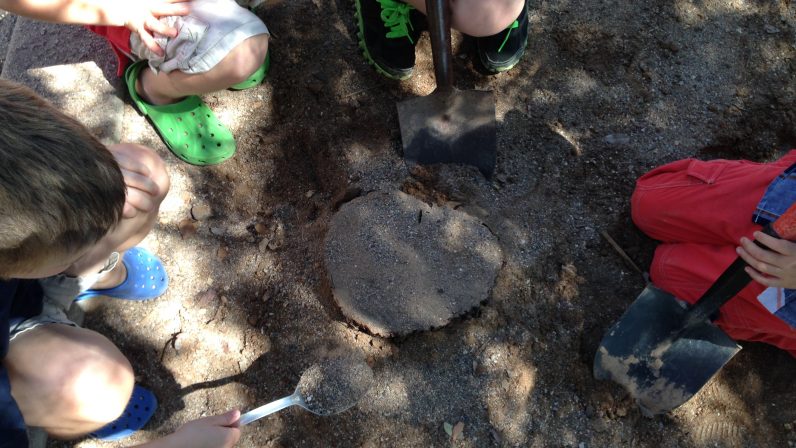Digging holes is sweaty business. Although the temperature is dropping theoretically, it’s still hot enough to be dripping with sweat at the end of a digging session. Over the summer I had the idea to take a few of our excellent logs and partially bury them around the second sand circle to make a pathway. Inspiration for this idea came from the kids last spring, who were using most of the pots, pans and small metal bowls as stepping stones around that same sand circle. It was imaginative, creative and innovative. The only problem was, it damaged many of the brand new little bowls that weren’t designed to be stepped on. The logs seemed like a plausible alternative.
For most of the summer, just a few logs lined the concrete sand circle curb. A few weeks ago, I started in on them again. The rains were helpful in softening the ground and I kept at it, mostly in the afternoons when no one else was on the playground. This week I shifted my plan and started putting the logs in while the kids were at recess. The log project took on a whole new life. Of course, there were the questions: “What are you doing?” “Are you digging?” “Why are you digging?” My favorite: “Why are you digging up the logs?”
A curious initial crowd gathered around and several children wanted to help. Getting the concept across that standing in the middle of where the digging was going on wasn’t the most effective way to help was a preliminary challenge. There was a core group destined for digging and got their hands on the shovels regardless of who else was present. These kids know how to dig and stayed with me on more than one occasion. They cleared dirt from holes, measured the holes’ depth with spoon handles and offered their expert engineering advice whether it was asked for or not. When each log was fitted into its hole and the top was level, they scurried after the task of filling in dirt around the log like a bunch of human gophers. They stomped dirt next to the log to pack it down, stood on the log to check its stability, and tested out the distance between logs for stepping accessibility. It was a full-fledged engineering operation.
Just as impressive as the engineering was the collaboration. Although it was a little chaotic when the shovels and logs first arrived on the scene, eventually everyone who wanted a turn got one. Three-year-olds and third graders, girls and boys, quiet and high energy kids, all pitched in. Communication and collaboration are key components of STEM and STEAM education. Sand and dirt are frequent materials recommended for STEM work in early childhood education. I saw firsthand how sand, dirt and collaboration all came together with the hole digging project. I’m certain it will be followed by many similar projects, at the Seed and in the individual lives of children.

